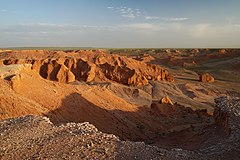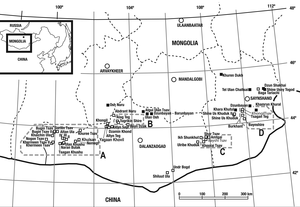
Velociraptor is a genus of small dromaeosaurid dinosaurs that lived in Asia during the Late Cretaceous epoch, about 75 million to 71 million years ago. Two species are currently recognized, although others have been assigned in the past. The type species is V. mongoliensis, named and described in 1924. Fossils of this species have been discovered in the Djadochta Formation, Mongolia. A second species, V. osmolskae, was named in 2008 for skull material from the Bayan Mandahu Formation, China.

Oviraptor is a genus of oviraptorid dinosaur that lived in Asia during the Late Cretaceous period. The first remains were collected from the Djadokhta Formation of Mongolia in 1923 during a paleontological expedition led by Roy Chapman Andrews, and in the following year the genus and type species Oviraptor philoceratops were named by Henry Fairfield Osborn. The genus name refers to the initial thought of egg-stealing habits, and the specific name was intended to reinforce this view indicating a preference over ceratopsian eggs. Despite the fact that numerous specimens have been referred to the genus, Oviraptor is only known from a single partial skeleton regarded as the holotype, as well as a nest of about fifteen eggs and several small fragments from a juvenile.

Protoceratops is a genus of small protoceratopsid dinosaurs that lived in Asia during the Late Cretaceous, around 75 to 71 million years ago. The genus Protoceratops includes two species: P. andrewsi and the larger P. hellenikorhinus. The former was described in 1923 with fossils from the Mongolian Djadokhta Formation, and the latter in 2001 with fossils from the Chinese Bayan Mandahu Formation. Protoceratops was initially believed to be an ancestor of ankylosaurians and larger ceratopsians, such as Triceratops and relatives, until the discoveries of other protoceratopsids. Populations of P. andrewsi may have evolved into Bagaceratops through anagenesis.
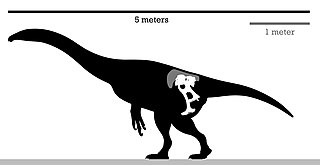
Enigmosaurus is a genus of therizinosauroid that lived in Asia during the Late Cretaceous period. It was a medium-sized, ground-dwelling, bipedal herbivore that represents the third therizinosaur taxon from the Bayan Shireh Formation, although it is known from the lower part. The genus is monotypic, including only the type species E. mongoliensis, known from a well preserved pelvis and other tentative body remains.

Bagaceratops is a genus of small protoceratopsid dinosaurs that lived in Asia during the Late Cretaceous, around 72 to 71 million years ago. Bagaceratops remains have been reported from the Barun Goyot Formation and Bayan Mandahu Formation. One specimen may argue the possible presence of Bagaceratops in the Djadochta Formation.

The Bayan Shireh Formation is a geological formation in Mongolia, that dates to the Cretaceous period. It was first described and established by Vasiliev et al. 1959.
Bainoceratops is a genus of ceratopsian dinosaur from the late Campanian in the Late Cretaceous. The type species is B. efremovi. Its fossils were found in southern Mongolia in the Djadochta Formation.

Citipati is a genus of oviraptorid dinosaur that lived in Asia during the Late Cretaceous period, about 75 million to 71 million years ago. It is mainly known from the Ukhaa Tolgod locality at the Djadochta Formation, where the first remains were collected during the 1990s. The genus and type species Citipati osmolskae were named and described in 2001. A second species from the adjacent Zamyn Khondt locality may also exist. Citipati is one of the best-known oviraptorids thanks to a number of well-preserved specimens, including individuals found in brooding positions atop nests of eggs, though most of them were initially referred to the related Oviraptor. These nesting specimens have helped to solidify the link between non-avian dinosaurs and birds.

The Barun Goyot Formation is a geological formation dating to the Late Cretaceous Period. It is located within and is widely represented in the Gobi Desert Basin, in the Ömnögovi Province of Mongolia.

The Nemegt Formation is a geological formation in the Gobi Desert of Mongolia, dating to the Late Cretaceous. The formation consists of river channel sediments and contains fossils of fish, turtles, crocodilians, and a diverse fauna of dinosaurs, including birds.

Tsaagan is a genus of dromaeosaurid dinosaur from the Djadokhta Formation of the Late Cretaceous of Mongolia.
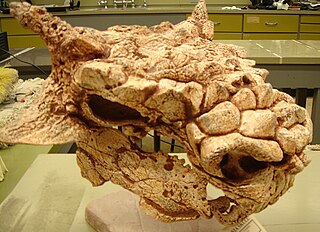
Minotaurasaurus is a monospecific genus of ankylosaurid dinosaur that lived in Mongolia during the Late Cretaceous in what is now the Djadochta Formation. The type and only species, Minotaurasaurus ramachandrani, is known from two skulls, a cervical vertebra and a cervical half ring. It was named and described in 2009 by Clifford Miles and Clark Miles. The first fossils of Minotaurasaurus were illegally exported out of Mongolia.It has been suggested to be a synonym of Tarchia but more recent publications consider it as a distinct genus.
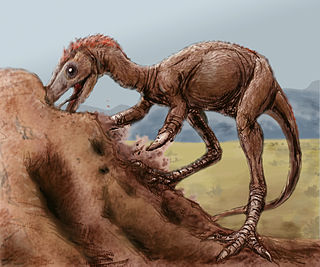
Kol is an extinct genus of coelurosaurian theropod dinosaur from the Late Cretaceous of Mongolia. The type and only species is Kol ghuva. The type specimen was excavated from the Ukhaa Tolgod locality of the Djadochta Formation, dating to about 75 million years ago. It is believed to have been about twice the size of the contemporaneous Shuvuuia. However, unlike Shuvuuia, which is known from many well preserved specimens, and although Ukhaa Tolgod has been thoroughly explored, Kol is known only from one complete foot, suggesting that it must have been relatively rare in that ecosystem.
Aiolosaurus is an extinct genus of monitor lizard from the Late Cretaceous of Mongolia. The type and only species, Aiolosaurus oriens, was named in 2000 from Ukhaa Tolgod, a rich fossil site in the Campanian-age Djadochta Formation.
Priscagamidae is an extinct family of iguanian lizards known from the Late Cretaceous of Mongolia and China and the Eocene of India, spanning a range from 83.6 to 48.6 million years ago. Probably the earliest priscagamids on indeterminate genera were found in Aptian-Albian sediments in "Hobur", Mongolia. It includes the genera Heterodontagama, Mimeosaurus, Phrynosomimus, Priscagama, and possibly Pleurodontagama. The first fossils of priscagamids were found in the Djadochta and Khermeen Tsav formations of Mongolia. More recently they have been found in the Cambay Formation in India, leading to the naming of Heterodontagama in 2013. Priscagamidae was originally described as a subfamily of Agamidae called Priscagaminae in 1984, but it was reclassified as a distinct family in 1989. Most phylogenetic analyses still find a close relationship between Priscagamidae and Agamidae, although a 2015 study found it to be basal to all other iguanian clades, warranting its removal from Iguania and placement in a larger clade called Iguanomorpha.
Saichangurvel is an extinct genus of iguanian lizards from the Late Cretaceous of Mongolia. It is a member of a clade called Gobiguania, an exclusively Late Cretaceous group of iguanian lizards that was likely endemic to the Gobi Desert. The type species, Saichangurvel davidsoni, was named by paleontologists Jack Conrad and Mark Norell of the American Museum of Natural History in 2007. It is known from a single nearly complete and fully articulated skeleton called IGM 3/858, which was found eroding from a block of sandstone during a thunderstorm at a fossil locality called Ukhaa Tolgod. IGM 3/858 comes from the Djadochta Formation, which is between 75 and 71 million years in age. Just as it is today, the Gobi was a desert during the Cretaceous. IGM 3/858 may have died in a collapsing sand dune, the rapid burial preserving its skeleton in pristine condition.

Almas is a genus of troodontid theropod dinosaur from the Late Cretaceous of Mongolia. It contains a single species, Almas ukhaa, named in 2017 by Pei Rui and colleagues, based on a partial articulated skeleton. The only known specimen was found in the Djadochta Formation, which is late Campanian in age.

The Javkhlant Formation is a geological formation in Mongolia whose strata date back to the Late Cretaceous possibly Santonian to Campanian. Ceratopsian, ornithopod and theropod remains been found in the formation. A prominent fossilized therizinosauroid nesting site is also known from the formation.

Natovenator is a genus of halszkaraptorine dromaeosaurid dinosaur from the Late Cretaceous Barun Goyot Formation of Mongolia. The genus is known from a single species, N. polydontus. Natovenator is crucial to the understanding of halszkaraptorines due to it providing more support for the semi-aquatic lifestyle that has been proposed for this clade. This discovery is important as the semi-aquatic lifestyles of halszkaraptorines was contested in early 2022.
